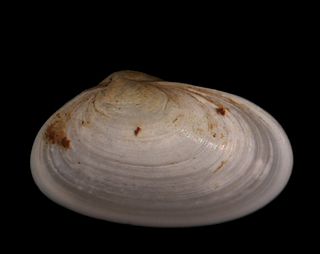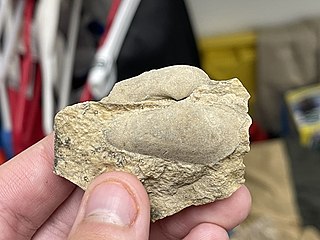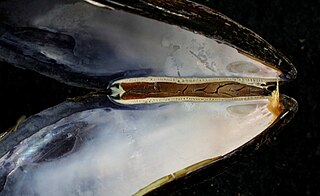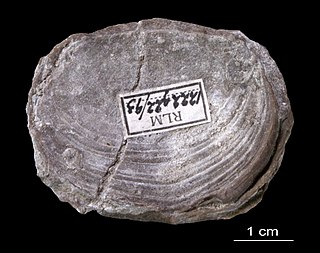
The Rostroconchia is a class of extinct molluscs dating from the early Cambrian to the Late Permian. They were initially thought to be bivalves, but were later given their own class. They have a single shell in their larval stage, and the adult typically has a single, pseudo-bivalved shell enclosing the mantle and muscular foot. The anterior part of the shell probably pointed downward and had a gap from which the foot could probably emerge. Rostroconchs probably lived a sedentary semi-infaunal lifestyle. There were probably more than 1,000 species of members of this class.
Necatia is a genus of the jumping spider family Salticidae. Its only species, Necatia magnidens, is found in southern China.
Praenuculidae is an extinct family of prehistoric bivalves in the superfamily Nuculoidea. Praenuculidae species lived from the early Ordovician, Arenig stage through the Early Devonian Emsian stage. Praenuculidae fossils are found worldwide, present on every continent except Antarctica. Species in this family are thought to have been sessile, attached to the substrate in shallow infaunal marine water environments, where they formed shells of an aragonite composition. The family Praenuculidae was named by A. Lee McAlester in 1969.

A bivalve shell is the enveloping exoskeleton or shell of a bivalve mollusc, composed of two hinged halves or valves. The two half-shells, called the "right valve" and "left valve", are joined by a ligament and usually articulate with one another using structures known as "teeth" which are situated along the hinge line. In many bivalve shells, the two valves are symmetrical along the hinge line — when truly symmetrical, such an animal is said to be equivalved; if the valves vary from each other in size or shape, inequivalved. If symmetrical front-to-back, the valves are said to be equilateral, and are otherwise considered inequilateral.

Rhynchonelliformea is a major subphylum and clade of brachiopods. It is roughly equivalent to the former class Articulata, which was used previously in brachiopod taxonomy up until the 1990s. These so-called articulated brachiopods have many anatomical differences relative to "inarticulate" brachiopods of the subphyla Linguliformea and Craniformea. Articulates have hard calcium carbonate shells with tongue-and-groove hinge articulations and separate sets of simple opening and closing muscles.
Pojetaia is an extinct genus of early bivalves, one of two genera in the extinct family Fordillidae. The genus is known solely from Early to Middle Cambrian fossils found in North America, Greenland, Europe, North Africa, Asia, and Australia. The genus currently contains two accepted species, Pojetaia runnegari, the type species, and Pojetaia sarhroensis, though up to seven species have been proposed. The genera Buluniella, Jellia, and Oryzoconcha are all considered synonyms of Pojetaia.

Tellimya ferruginosa is a species of small marine bivalve mollusc in the family Lasaeidae. It is found on the eastern side of the Atlantic Ocean.

Fordillidae is an extinct family of early bivalves and one of two families in the extinct superfamily Fordilloidea. The family is known from fossils of early to middle Cambrian age found in North America, Greenland, Europe, the Middle East, Asia, and Australia. The family currently contains two genera, Fordilla and Pojetaia, each with up to three described species. Due to the size and age of the fossil specimens, Fordillidae species are included as part of the Turkish Small shelly fauna.
Camya is an extinct genus of early bivalve and is the only genus in the extinct family Camyidae. The genus is known solely from early Middle Cambrian fossils found in Europe. The genus currently contains a solitary accepted species, Camya asy.

Fordilloidea is an extinct superfamily of early bivalves containing two described families, Fordillidae and Camyidae and the only superfamily in the order Fordillida. The superfamily is known from fossils of early to middle Cambrian age found in North America, Greenland, Europe, the Middle East, Asia, and Australia. Fordillidae currently contains two genera, Fordilla and Pojetaia each with up to three described species while Camyidae only contains a single genus Camya with one described species, Camya asy. Due to the size and age of the fossil specimens, Fordillidae species are included as part of the Turkish Small shelly fauna.
Concavodonta is an extinct genus of early bivalve in the extinct family Praenuculidae. The genus is one of three genera in the subfamily Concavodontinae. Concavodonta is known solely from late Ordovician, Caradoc epoch, fossils found in Europe and South America. The genus currently contains three accepted species, Concavodonta imbricata, Concavodonta ovalis and the type species Concavodonta ponderata.
Hemiconcavodonta is an extinct genus of bivalve in the extinct family Praenuculidae. The genus is one of three genera in the subfamily Concavodontinae. Hemiconcavodonta is known solely from late Ordovician, Caradoc epoch, fossils found in South America. The genus currently contains a single accepted species, Hemiconcavodonta minuta.
Emiliodonta is an extinct genus of bivalve in the extinct family Praenuculidae. The genus is one of three genera in the subfamily Concavodontinae. Emiliodonta is known solely from late Ordovician, Caradocian epoch, fossils found in South America. The genus contains a single accepted species, Emiliodonta cuerdai.
Praenuculinae is an extinct subfamily of prehistoric bivalves in the family Praenuculidae. Praenuculinae species lived from the middle Ordovician through the late Devonian. Praenuculinae fossils are found in Europe, Africa, North America and South America, and species are thought to have been stationary attached to substrate in shallow infaunal marine water environments where they formed shells of an aragonite composition. The subfamily Praenuculinae was named by Teresa M. Sánchez in 1999.
Cuyopsis is an extinct genus of bivalve in the extinct family Praenuculidae. The genus is one of eleven genera in the subfamily Praenuculinae. It is one of three Praenuculinae genera known solely from late Ordivician, Caradoc epoch, fossils found in South America. Cuyopsis currently contains a single accepted species, Cuyopsis symmetricus.
Villicumia is an extinct genus of bivalve in the extinct family Praenuculidae. The genus is one of eleven genera in the subfamily Praenuculinae. It is one of three Praenuculinae genera known solely from late Ordovician, Caradoc epoch, fossils found in South America. Villicumia currently contains a single accepted species, Villicumia canteraensis.
Trigonoconcha is an extinct genus of bivalve in the extinct family Praenuculidae. The genus is one of eleven genera in the subfamily Praenuculinae. It is one of three Praenuculinae genera known solely from Late Ordivician, Caradoc epoch, fossils found in South America. Trigonoconcha currently contains a single accepted species, Trigonoconcha acuta.

Similodonta is an extinct genus of early bivalve in the extinct family Praenuculidae. The genus is one of eleven genera in the subfamily Praenuculinae. Similodonta is known from Middle Ordovician through Middle Silurian fossils found in Europe and North America. The genus currently contains eight accepted species, Similodonta ceryx, Similodonta collina, Similodonta djupvikensis, Similodonta magna, Similodonta recurva, Similodonta spjeldnaesi, Similodonta wahli and the type species Similodonta similis.

A hinge ligament is a crucial part of the anatomical structure of a bivalve shell, i.e. the shell of a bivalve mollusk. The shell of a bivalve has two valves and these are joined by the ligament at the dorsal edge of the shell. The ligament is made of a strong, flexible and elastic, fibrous, proteinaceous material which is usually pale brown, dark brown or black in color.

Trimerellida is an extinct order of craniate brachiopods, containing the sole superfamily Trimerelloidea and the families Adensuidae, Trimerellidae, and Ussuniidae. Trimerellidae was a widespread family of warm-water brachiopods ranging from the Middle Ordovician to the late Silurian (Ludlow). Adensuidae and Ussuniidae are monogeneric families restricted to the Ordovician of Kazakhstan. Most individuals were free-living, though some clustered into large congregations similar to modern oyster reefs.







